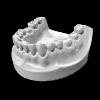r e v e r s e e n g i n e e r i n g
3 d s c a n

r e v e r s e e n g i n e e r i n g
3 d s c a n

What you want/need to know about reverse engineering
A 3D Scan of an object using a laser scanner produces a collection of points with a certain density (which depends on the used equipment). This collection of points is usually called a Point Cloud. In order to be able to use these data, the points have to be interconnected, and form a triangle mesh. This step is mostly done by dedicated scan software. The mesh can be further processed within Rhino 8. This process involves mesh repair, mesh correction.
In order to manipulate and correct measurements, the mesh has to be turned into a NURBS model. The easiest way to do that is by using a plugin, which automates certain Rhino routines. The created model can then be printed or milled.
This sequence from scan to fab is called reverse engineering.
Reverse engineering in Rhino is not the easiest thing, and utterly time consuming. Luckily adequate software is available. The two best plugins are Mesh2Surface and RhinoResurf, simplifying reverse engineering tasks in Rhinoceros. The plugins help engineers and designers to convert digitized objects – point clouds & meshes – to printable and millable models.
Mesh2Surface
Mesh2Surface streamlines and optimizes converting scanned data into a perfect NURBS model. The tools available are: Fit basic primitives; Revolved and extruded surfaces; Advanced editing of profile for revolved and extruded surfaces; Segment meshes based on fillet areas; Measure the fillet radius; Constraint extracted shapes; Find the symmetry of the object; Align an object to the world coordinate system; Build best fit free form surface from part of the mesh; Create curve based free form surface; Deviation analyzer. Mesh2Surface does it all.
For instruction videos, click here
RhinoResurf
RhinoResurf for Rhino, a reverse engineering tool that gives Rhino the ability to reconstruct NURBS surface(s) from mesh or point cloud with specified precision. RhinoResurf also provide features for free-form surface modeling from polygon lines or meshes.
RhinoResurf is designed in a way that the plugin is very user friendly, and easy to understand. Once loaded manually on first use, it will automatically load itself into the Rhino environment later. The new commands will be added to Rhino’s existing commands, and a new submenu called RhinoResurf will be created.